浙教版七年级上册科学第四章《物质的特性》知识点(新教材)
浙教版七年级上科学第四章知识点

七年级(上)科学第四章物质的特性一、学问点构造图二、根底学问点1、物质的构成1.1 Q:什么是分子?A:分子是构成物质的一种极其微小的粒子。
1.2 Q:分子的性质有什么?A:①分子很小②分子之间存在空隙③分子不停的做无规则运动④同种分子之间有斥力,不同种分子之间存在斥力。
1.3 Q:气体或液体扩散速度跟温度的关系是什么?A:温度越高,气体或液体扩散的越快。
1.4 Q:气体液体固体三者分子之间空隙排列是怎样的?A:气体分子之间空隙最大,液体分子次之,固体分子之间间隙比拟小。
1.5 Q:扩散现象说明了什么?A:一切分子都在不停的做无规则运动,还能说明分子之间有空隙。
1.6 Q:我们通常把分子的运动也叫作什么?A:分子的运动与温度有关,所以这种无规则的运动叫做分子的热运动。
物体的温度越高,分子的热运动越猛烈。
1.7 Q:既然构成各种物质的分子之间都存在空隙,为什么很难将固体和液体的体积压缩呢?A:物质内部的分子之间不仅存在引力,同事也存在斥力。
正是分子之间的斥力使物质内部的分子很难靠的很近。
2、质量的测量2.1 Q:什么是质量?A:表示物体所含物质的多少。
2.2 Q:质量会随物体形态的变更而变更吗?A:质量是物体本身的一种属性,其大小不会随物体的形态,状态,温度,位置的变更而变更。
2.3 Q:物质的单位及单位换算A:物体质量的主要单位(标准单位)是千克,符号kg。
常用单位有:吨(t),克(g),毫克(mg)单位换算:1吨=1000千克 1千克=1000克=106毫克 1克=1000毫克2.4 Q:托盘天平的根本构造是A:左盘、右盘、平衡螺母、游码、底座、分度盘、指针、横梁标尺、砝码及砝码盒、镊子。
2.5 Q:运用天平留意事项A:留意称量值不能超过量程(最大称量值)玛法不能用手干脆取,应用镊子取,称后刚好放回砝码盒,以免生锈。
防止天平与潮湿、有腐蚀性的物体接触。
加砝码时要轻放轻拿化学药品不能干脆放在托盘上(可在两个盘中都垫上大小质量一样的两张纸或两个玻璃器皿再称量)。
浙教版《科学》七年级上(第四章)知识点整理
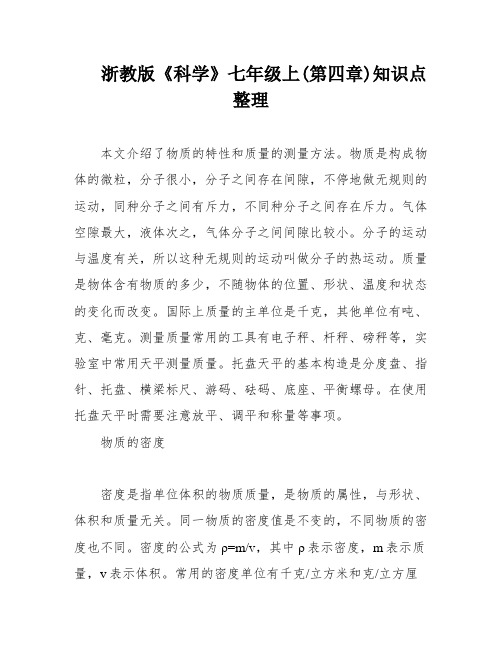
浙教版《科学》七年级上(第四章)知识点整理本文介绍了物质的特性和质量的测量方法。
物质是构成物体的微粒,分子很小,分子之间存在间隙,不停地做无规则的运动,同种分子之间有斥力,不同种分子之间存在斥力。
气体空隙最大,液体次之,气体分子之间间隙比较小。
分子的运动与温度有关,所以这种无规则的运动叫做分子的热运动。
质量是物体含有物质的多少,不随物体的位置、形状、温度和状态的变化而改变。
国际上质量的主单位是千克,其他单位有吨、克、毫克。
测量质量常用的工具有电子秤、杆秤、磅秤等,实验室中常用天平测量质量。
托盘天平的基本构造是分度盘、指针、托盘、横梁标尺、游码、砝码、底座、平衡螺母。
在使用托盘天平时需要注意放平、调平和称量等事项。
物质的密度密度是指单位体积的物质质量,是物质的属性,与形状、体积和质量无关。
同一物质的密度值是不变的,不同物质的密度也不同。
密度的公式为ρ=m/v,其中ρ表示密度,m表示质量,v表示体积。
常用的密度单位有千克/立方米和克/立方厘米。
水的密度为1克/立方厘米或1×10³千克/立方米。
密度的测量需要用到天平、量筒或量杯等工具。
物质的比热比热是指单位质量的物质在升高或降低1℃时所吸收或放出的热量。
比热的单位为焦/(千克×℃),读作焦每千克摄氏度。
水的比热为4.2×10³焦/(千克×℃),表示1千克水升高1℃需要吸收4.2×10³焦的热量。
比热表可以用于读取不同物质的比热值。
1.水的比热是最大的,这说明水可以被用作冷却剂和保温剂。
2.比热是物质的一种特性,不同物质的比热不同。
比热与物质的质量、升高的温度、吸放热的多少无关,但与物质的状态有关。
3.沿海地区的气温变化较小,而内陆地区的气温变化较大。
在同一纬度的海洋和陆地上,冬季陆地降温快,海洋降温慢;夏季陆地降升温快,海洋降升温慢。
这是因为海洋(水)的比热容比陆地(岩石)要大,所以升温较慢。
浙教版七年级科学上第四章物质的特性知识要点
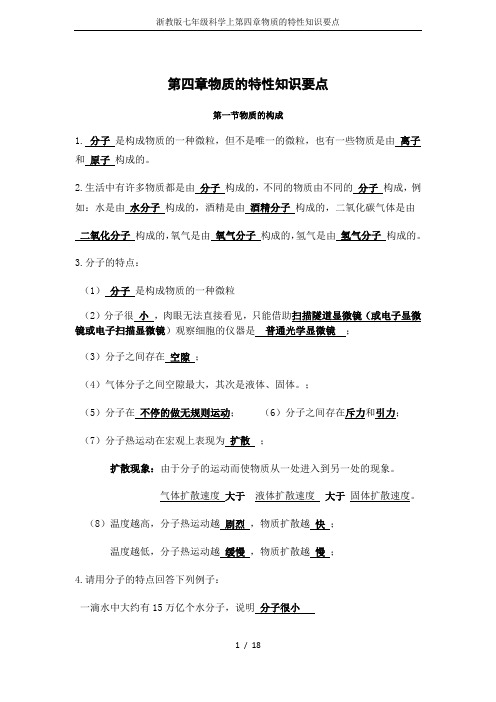
第四章物质的特性知识要点第一节物质的构成1. 分子是构成物质的一种微粒,但不是唯一的微粒,也有一些物质是由离子和原子构成的。
2.生活中有许多物质都是由分子构成的,不同的物质由不同的分子构成,例如:水是由水分子构成的,酒精是由酒精分子构成的,二氧化碳气体是由二氧化分子构成的,氧气是由氧气分子构成的,氢气是由氢气分子构成的。
3.分子的特点:(1)分子是构成物质的一种微粒(2)分子很小,肉眼无法直接看见,只能借助扫描隧道显微镜(或电子显微镜或电子扫描显微镜)观察细胞的仪器是普通光学显微镜;(3)分子之间存在空隙;(4)气体分子之间空隙最大,其次是液体、固体。
;(5)分子在不停的做无规则运动;(6)分子之间存在斥力和引力;(7)分子热运动在宏观上表现为扩散;扩散现象:由于分子的运动而使物质从一处进入到另一处的现象。
气体扩散速度大于液体扩散速度大于固体扩散速度。
(8)温度越高,分子热运动越剧烈,物质扩散越快;温度越低,分子热运动越缓慢,物质扩散越慢;4.请用分子的特点回答下列例子:一滴水中大约有15万亿个水分子,说明分子很小一定体积的水与一定体积的酒精混合后总体积变小,说明分子间存在空隙一定体积的气体,很容易被压缩,说明气体分子间的空隙很大5. 50毫升的水与50毫升的酒精混合后的体积小于100ml ,原因是:当水和酒精混合时,较小的水分子进入到较大的酒精分子的空隙中去了,所以总体积会减小。
【注意:①若同种物质混合,如100mL水与100mL混合,则总体积不变。
②芝麻与黄豆混合后总体积变小的实验,是一个模拟实验,它并不能证明分子间有间隙。
】6.分子总是在不断做无规则运动,且随着温度的升高,分子的运动速度加快;分子间有空隙,随着温度的升高,分子的空隙增大;随着压力的增大,分子间的空隙缩小。
7.(1)用分子观点解释:春暖花开的季节里.人们在公园里通常能闻到宜人的花香,这是因为分子在不停的做无规则运动;(2)为了便于运输和使用,通常把石油气加压变成液化石油气贮存在钢瓶里。
七年级上浙教版科学第四章《物质的特性》复习提纲
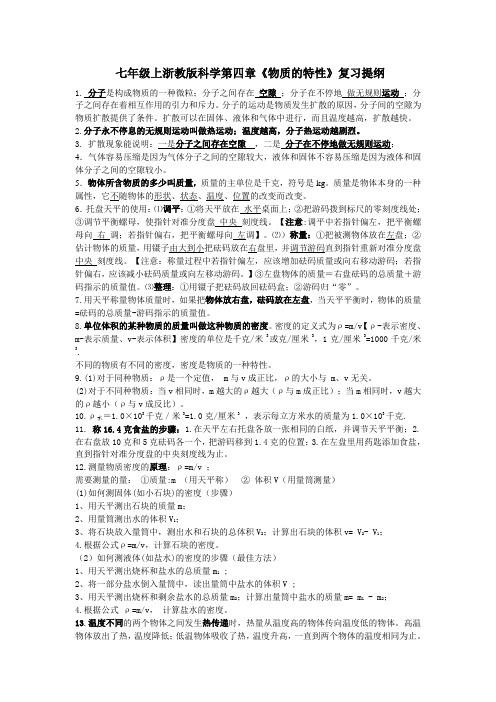
七年级上浙教版科学第四章《物质的特性》复习提纲1.分子是构成物质的一种微粒;分子之间存在空隙;分子在不停地做无规则运动;分子之间存在着相互作用的引力和斥力。
分子的运动是物质发生扩散的原因,分子间的空隙为物质扩散提供了条件。
扩散可以在固体、液体和气体中进行,而且温度越高,扩散越快。
2.分子永不停息的无规则运动叫做热运动;温度越高,分子热运动越剧烈。
3. 扩散现象能说明:一是分子之间存在空隙,二是分子在不停地做无规则运动;4.气体容易压缩是因为气体分子之间的空隙较大,液体和固体不容易压缩是因为液体和固体分子之间的空隙较小。
5.物体所含物质的多少叫质量,质量的主单位是千克,符号是kg。
质量是物体本身的一种属性,它不随物体的形状、状态、温度、位置的改变而改变。
6.托盘天平的使用:⑴调平:①将天平放在水平桌面上;②把游码拨到标尺的零刻度线处;③调节平衡螺母,使指针对准分度盘中央刻度线。
【注意:调平中若指针偏左,把平衡螺母向右调;若指针偏右,把平衡螺母向左调】。
⑵)称量:①把被测物体放在左盘;②估计物体的质量,用镊子由大到小把砝码放在右盘里,并调节游码直到指针重新对准分度盘中央刻度线。
【注意:称量过程中若指针偏左,应该增加砝码质量或向右移动游码;若指针偏右,应该减小砝码质量或向左移动游码。
】③左盘物体的质量=右盘砝码的总质量+游码指示的质量值。
⑶整理:①用镊子把砝码放回砝码盒;②游码归“零”。
7.用天平称量物体质量时,如果把物体放右盘,砝码放在左盘,当天平平衡时,物体的质量=砝码的总质量-游码指示的质量值。
8.单位体积的某种物质的质量叫做这种物质的密度。
密度的定义式为ρ=m/v【ρ-表示密度、m-表示质量、v-表示体积】密度的单位是千克/米3或克/厘米3,1克/厘米3=1000千克/米3.不同的物质有不同的密度,密度是物质的一种特性。
9.(1)对于同种物质:ρ是一个定值, m与v成正比,ρ的大小与 m、v无关。
新浙教版七年级科学上册第四单元复习提纲

第四章物质的特性第1节物质的构成1.分子是构成物质的一种。
但也有许多物质是由或等微粒构成的。
分子十分很小(用电子扫描隧道显微镜才能看见较大的分子)。
2.分子运动论的基本内容:(1)分子之间存在;(2)分子在运动,因此由分子构成的物质会发生现象;且温度越高,现象越明显,分子运动越。
(3)分子间存在相互作用的和。
(两个铅柱被粘合在一起很难被拉开,证明了什么?)3.酒精和水混合实验:芝麻与黄豆混合后总体积变小的实验,是一个模拟实验,它并不能证明分子间有间隙。
4.气体很容易被压缩而液体和固体很难被压缩,比较固体、液体、气体的分子空隙的大小(水例外): > >5.扩散现象证明了:一是,二是。
6.冰融化成水后,体积会变小,为什么?解释:这说明冰中水分子之间的空隙比液态水中的要。
7.气体、液体、固体都会发生扩散现象。
第2节质量的测量1.质量的概念:物体所含物质的多少2. 质量的单位:国际上质量的主单位是。
单位符号是。
还有一些常用单位:吨、克、毫克。
1吨=千克,I千克=克,1克= 毫克。
2.质量是物质的一种属性,不随物体的形状、状态、温度、位置的变化而变化。
4.测量质量的常用工具有电子秤、杆秤、磅秤、案秤等。
实验室中常用来测量质量5.托盘天平的基本构造:(1)(2)(3)(4)(5)(6)(7)(8)6.使用托盘天平时要注意以下事项:(1)放平:将托盘天平放在 桌面上。
(2)调平:将 拨至“0”刻度线处。
调节平衡螺母,使指针对准分度盘中央刻度线。
【思考:当指针偏转时,应如何调节平衡螺母?】(3)称量:砝码和物体的放置要求:左盘物体质量= 右盘 +加砝码时,先估测,用镊子由 加到 ,等砝码加到指针离分度盘中央刻度线不多时(在中央刻度线略偏左边),应向 右 移动 游码 (此时 移动平衡螺母),直到天平再次平衡。
(4)整理器材:用 将砝码放回砝码盒中, 移回“0”刻度线处。
【思考:如果物体和砝码放置的位置反了,这时怎样求得物体的实际质量?】【思考:砝码生锈,测量值偏 ;砝码磨损,测量值偏 。
浙教版七年级上册科学知识点汇总 - 第四章
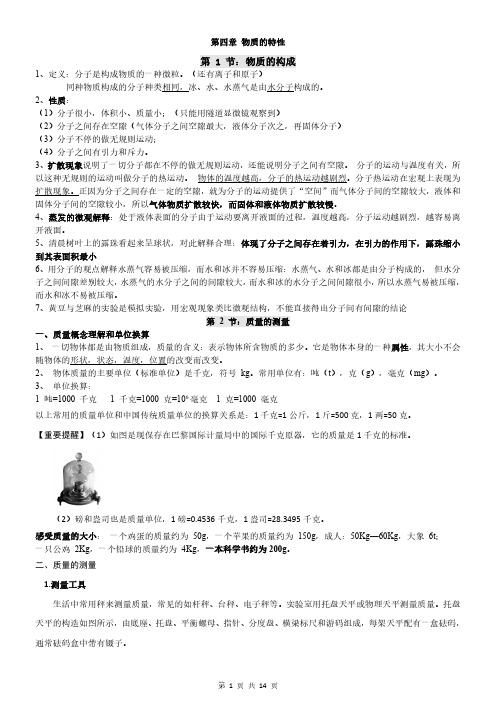
第四章物质的特性第1节:物质的构成1、定义:分子是构成物质的一种微粒。
(还有离子和原子)同种物质构成的分子种类相同,冰、水、水蒸气是由水分子构成的。
2、性质:(1)分子很小,体积小、质量小;(只能用隧道显微镜观察到)(2)分子之间存在空隙(气体分子之间空隙最大,液体分子次之,再固体分子)(3)分子不停的做无规则运动;(4)分子之间有引力和斥力。
3、扩散现象说明了一切分子都在不停的做无规则运动,还能说明分子之间有空隙。
分子的运动与温度有关,所以这种无规则的运动叫做分子的热运动。
物体的温度越高,分子的热运动越剧烈。
分子热运动在宏观上表现为扩散现象。
正因为分子之间存在一定的空隙,就为分子的运动提供了“空间”而气体分子间的空隙较大,液体和固体分子间的空隙较小,所以气体物质扩散较快,而固体和液体物质扩散较慢。
4、蒸发的微观解释:处于液体表面的分子由于运动要离开液面的过程,温度越高,分子运动越剧烈,越容易离开液面。
5、清晨树叶上的露珠看起来呈球状,对此解释合理:体现了分子之间存在着引力,在引力的作用下,露珠缩小到其表面积最小6、用分子的观点解释水蒸气容易被压缩,而水和冰并不容易压缩:水蒸气、水和冰都是由分子构成的,但水分子之间间隙差别较大,水蒸气的水分子之间的间隙较大,而水和冰的水分子之间间隙很小,所以水蒸气易被压缩,而水和冰不易被压缩。
7、黄豆与芝麻的实验是模拟实验,用宏观现象类比微观结构,不能直接得出分子间有间隙的结论第2节:质量的测量一、质量概念理解和单位换算1、一切物体都是由物质组成,质量的含义:表示物体所含物质的多少。
它是物体本身的一种属性,其大小不会随物体的形状,状态,温度,位置的改变而改变。
2、物体质量的主要单位(标准单位)是千克,符号kg。
常用单位有:吨(t),克(g),毫克(mg)。
3、单位换算:1吨=1000千克1千克=1000克=106毫克1克=1000毫克以上常用的质量单位和中国传统质量单位的换算关系是:1千克=1公斤,1斤=500克,1两=50克。
新浙教版科学七上第四章主要内容、生活中的科学
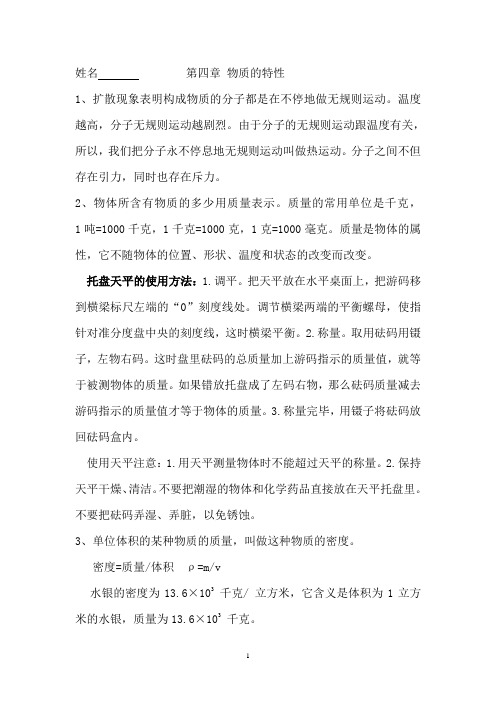
姓名第四章物质的特性1、扩散现象表明构成物质的分子都是在不停地做无规则运动。
温度越高,分子无规则运动越剧烈。
由于分子的无规则运动跟温度有关,所以,我们把分子永不停息地无规则运动叫做热运动。
分子之间不但存在引力,同时也存在斥力。
2、物体所含有物质的多少用质量表示。
质量的常用单位是千克,1吨=1000千克,1千克=1000克,1克=1000毫克。
质量是物体的属性,它不随物体的位置、形状、温度和状态的改变而改变。
托盘天平的使用方法:1.调平。
把天平放在水平桌面上,把游码移到横梁标尺左端的“0”刻度线处。
调节横梁两端的平衡螺母,使指针对准分度盘中央的刻度线,这时横梁平衡。
2.称量。
取用砝码用镊子,左物右码。
这时盘里砝码的总质量加上游码指示的质量值,就等于被测物体的质量。
如果错放托盘成了左码右物,那么砝码质量减去游码指示的质量值才等于物体的质量。
3.称量完毕,用镊子将砝码放回砝码盒内。
使用天平注意:1.用天平测量物体时不能超过天平的称量。
2.保持天平干燥、清洁。
不要把潮湿的物体和化学药品直接放在天平托盘里。
不要把砝码弄湿、弄脏,以免锈蚀。
3、单位体积的某种物质的质量,叫做这种物质的密度。
密度=质量/体积ρ=m/v水银的密度为13.6×103千克/ 立方米,它含义是体积为1立方米的水银,质量为13.6×103千克。
4、物体吸收或放出热的多少叫热量。
热量的单位为焦耳。
物体吸收的热量除了跟质量和升高的温度有关,还跟比热有关。
5、物质从固态变成液态的过程叫熔化,从液态变成固态的过程叫凝固。
根据固体熔化时的不同特点,可将固体分为晶体和非晶体两类。
晶体具有一定的熔化温度,熔化时温度保持不变,非晶体没有一定的熔化温度,熔化时温度持续上升。
固体熔化时都要从外界吸收热量。
晶体熔化时温度叫做熔点,冰的熔点是0℃.不同晶体的熔点不同,同一晶体的熔点和凝固点相同。
6、物质由液态变为气态的过程叫汽化。
在任何温度下都能进行的汽化现象叫蒸发。
浙教版《科学》七年级上(第四章)核心知识点整理

浙教版《科学》七年级上(第四章)核心知识点整理第一节物质的分类1. 物质的分类方法:- 按物质的状态分为固体、液体和气体;- 按物质的组成分为单质和化合物;- 按物质的来源分为天然物和人工合成物。
2. 物质的性质:- 物质的物理性质包括颜色、形状、硬度、熔点、沸点等;- 物质的化学性质包括与其他物质发生反应所表现出的性质,如燃烧性、氧化性等。
第二节物质纯净与混合1. 纯净物和混合物的区别:- 纯净物由一种物质组成,具有确定的物质性质;- 混合物由两种或更多的物质组成,物质性质不确定。
2. 纯净物和混合物的分类:- 纯净物分为单质和化合物;- 混合物分为均质混合物和非均质混合物。
3. 均质混合物与非均质混合物的特点:- 均质混合物组成均匀,无法用肉眼看出组分;- 非均质混合物组成不均匀,可以用肉眼看出组分。
第三节纯净物质的提纯方法1. 浓缩与稀释:- 浓缩是指将混合物中的溶质浓度增加,通常通过蒸发去除溶剂实现;- 稀释是指将溶液中的溶质浓度降低,通常通过加入溶剂实现。
2. 结晶法:- 把溶液慢慢冷却,溶质逐渐结晶出来,再通过过滤等方法分离出纯净物质。
3. 用活性炭吸附:- 活性炭能够吸附杂质,通过与杂质的物质性质不同实现提纯。
4. 蒸馏法:- 利用物质的沸点不同,将混合物通过加热使其局部汽化,再通过冷凝使其变回液体,实现分离纯净物质。
第四节溶液的组成1. 溶质和溶剂:- 溶质是指能够在溶剂中溶解的物质;- 溶剂是指能够溶解其他物质的物质。
2. 浓溶液与稀溶液:- 浓溶液中溶质的质量含量高;- 稀溶液中溶质的质量含量低。
3. 饱和溶液与过饱和溶液:- 饱和溶液中已经溶解了最大量的溶质;- 过饱和溶液中溶质的含量超过了饱和度。
第五节溶液的分离1. 蒸发法:- 将溶液加热使溶剂蒸发,溶质留下,实现分离。
2. 结晶法:- 将溶液慢慢冷却,溶质结晶出来,通过过滤等方法分离溶质。
3. 沉淀法:- 利用溶液中溶剂加入其他物质时的反应产物成为沉淀,通过过滤等方法分离。
浙教版七年级科学上册第四章《物质的特性》复习提纲
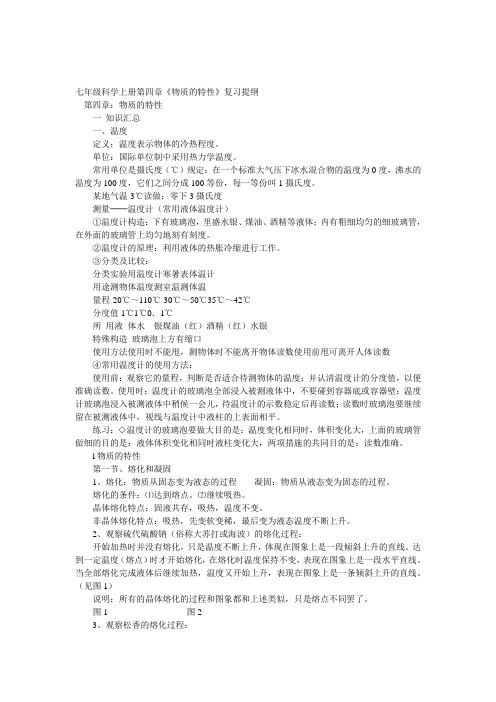
七年级科学上册第四章《物质的特性》复习提纲第四章:物质的特性一知识汇总一、温度定义:温度表示物体的冷热程度。
单位:国际单位制中采用热力学温度。
常用单位是摄氏度(℃)规定:在一个标准大气压下冰水混合物的温度为0度,沸水的温度为100度,它们之间分成100等份,每一等份叫1摄氏度。
某地气温-3℃读做:零下3摄氏度测量──温度计(常用液体温度计)①温度计构造:下有玻璃泡,里盛水银、煤油、酒精等液体;内有粗细均匀的细玻璃管,在外面的玻璃管上均匀地刻有刻度。
②温度计的原理:利用液体的热胀冷缩进行工作。
③分类及比较:分类实验用温度计寒暑表体温计用途测物体温度测室温测体温量程-20℃~110℃-30℃~50℃35℃~42℃分度值1℃1℃0.1℃所用液体水银煤油(红)酒精(红)水银特殊构造玻璃泡上方有缩口使用方法使用时不能甩,测物体时不能离开物体读数使用前甩可离开人体读数④常用温度计的使用方法:使用前:观察它的量程,判断是否适合待测物体的温度;并认清温度计的分度值,以便准确读数。
使用时:温度计的玻璃泡全部浸入被测液体中,不要碰到容器底或容器壁;温度计玻璃泡浸入被测液体中稍候一会儿,待温度计的示数稳定后再读数;读数时玻璃泡要继续留在被测液体中,视线与温度计中液柱的上表面相平。
练习:◇温度计的玻璃泡要做大目的是:温度变化相同时,体积变化大,上面的玻璃管做细的目的是:液体体积变化相同时液柱变化大,两项措施的共同目的是:读数准确。
l物质的特性第一节、熔化和凝固1、熔化:物质从固态变为液态的过程凝固:物质从液态变为固态的过程。
熔化的条件:⑴达到熔点。
⑵继续吸热。
晶体熔化特点:固液共存,吸热,温度不变。
非晶体熔化特点:吸热,先变软变稀,最后变为液态温度不断上升。
2、观察硫代硫酸钠(俗称大苏打或海波)的熔化过程:开始加热时并没有熔化,只是温度不断上升,体现在图象上是一段倾斜上升的直线。
达到一定温度(熔点)时才开始熔化,在熔化时温度保持不变,表现在图象上是一段水平直线。
浙教版七年级科学上第四章物质的特性知识要点
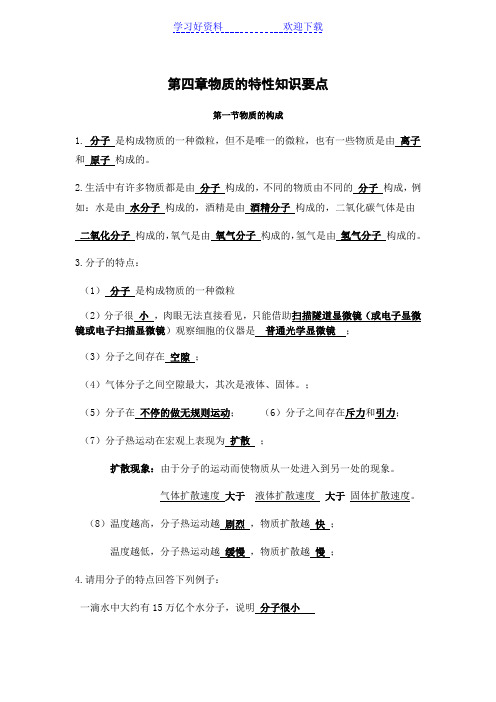
第四章物质的特性知识要点第一节物质的构成1. 分子是构成物质的一种微粒,但不是唯一的微粒,也有一些物质是由离子和原子构成的。
2.生活中有许多物质都是由分子构成的,不同的物质由不同的分子构成,例如:水是由水分子构成的,酒精是由酒精分子构成的,二氧化碳气体是由二氧化分子构成的,氧气是由氧气分子构成的,氢气是由氢气分子构成的。
3.分子的特点:(1)分子是构成物质的一种微粒(2)分子很小,肉眼无法直接看见,只能借助扫描隧道显微镜(或电子显微镜或电子扫描显微镜)观察细胞的仪器是普通光学显微镜;(3)分子之间存在空隙;(4)气体分子之间空隙最大,其次是液体、固体。
;(5)分子在不停的做无规则运动;(6)分子之间存在斥力和引力;(7)分子热运动在宏观上表现为扩散;扩散现象:由于分子的运动而使物质从一处进入到另一处的现象。
气体扩散速度大于液体扩散速度大于固体扩散速度。
(8)温度越高,分子热运动越剧烈,物质扩散越快;温度越低,分子热运动越缓慢,物质扩散越慢;4.请用分子的特点回答下列例子:一滴水中大约有15万亿个水分子,说明分子很小一定体积的水与一定体积的酒精混合后总体积变小,说明分子间存在空隙一定体积的气体,很容易被压缩,说明气体分子间的空隙很大5. 50毫升的水与50毫升的酒精混合后的体积小于100ml ,原因是:当水和酒精混合时,较小的水分子进入到较大的酒精分子的空隙中去了,所以总体积会减小。
【注意:①若同种物质混合,如100mL水与100mL混合,则总体积不变。
②芝麻与黄豆混合后总体积变小的实验,是一个模拟实验,它并不能证明分子间有间隙。
】6.分子总是在不断做无规则运动,且随着温度的升高,分子的运动速度加快;分子间有空隙,随着温度的升高,分子的空隙增大;随着压力的增大,分子间的空隙缩小。
7.(1)用分子观点解释:春暖花开的季节里.人们在公园里通常能闻到宜人的花香,这是因为分子在不停的做无规则运动;(2)为了便于运输和使用,通常把石油气加压变成液化石油气贮存在钢瓶里。
浙教版七年级科学上册第4章-物质的特性知识点

七年级上册第4章物质的特性知识点4.1物质的构成1、物质是由分子构成:分子是构成物质的一种极其微小的粒子,用扫描电子显微镜观察。
2、分子之间存在空隙:水和酒精混合后的总体积小于水和酒精的体积之和。
(气体分子之间空隙最大,液体第二,固体第三)3、分子处于不停的运动之中:扩散可以在固体、液体、气体中进行且温度越高,扩散越快。
扩散现象说明分子处于不停的运动之中和分子之间存在空隙。
4、分子之间存在着相互作用的引力和斥力。
练习1.一个厚壁钢瓶内盛有油,对油施加高压后,虽然瓶壁没有裂痕,但瓶内的油会从钢瓶壁渗出。
这个现象说明了什么?。
2.下列事例中,能说明分子在不停地做无规则运动的是()。
A.春天,柳絮飞扬B.夏天,荷花飘香C.秋天,黄沙扑面D.冬天,雪花飘飘3.将一根细线松松地系在一个铁丝框架的相对的两边上。
把框架浸到肥皂液里再取出来,框架上便会出现一层肥皂膜,如图4-12甲所示。
用烧热的针刺破线的一侧的肥皂膜,另一侧的肥皂膜会把细线拉过去,如图4-12乙。
这个实验现象说明()。
A.物体是由大量分子组成的B.分子之间存在着空隙C.分子不停地做无规则运动D.分子之间存在着引力4.人们发现,长期堆放煤炭的墙角,不但地表和墙的表面会变黑,而且在地面和墙面的里层都会变黑。
如何解释这一现象?4.2 质量的测量1、一切物体都是由物质组成的,质量表示物体所含物质的多少。
物体的质量是由物体本身决定的,是物质的一种属性,不随物体的位置、形状、温度、状态的改变而改变。
2、物体质量的单位是千克,用“kg”表示。
常用质量单位还有吨(t)、克(g)、毫克(㎎)。
单位换算:1吨=1000千克 1千克=1000克 1克=1000毫克3、实验室里常用天平来测量物体的质量。
(重、难)①调平。
把天平放在水平桌面上,把游码移到横梁标尺左端的零刻度线处。
调节衡量两端的平衡螺母(向指针偏转的相反方向),使指针对准分度盘中央刻度线,这时横梁平衡。
②称量。
新浙教版七年级科学上册第四章知识点
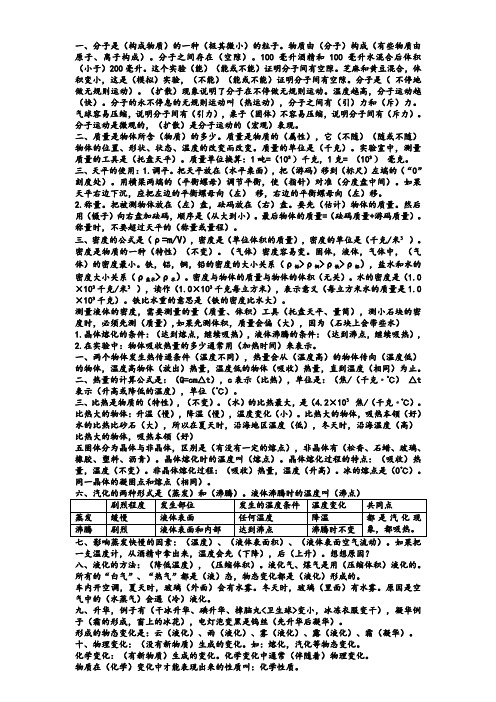
一、分子是(构成物质)的一种(极其微小)的粒子。
物质由(分子)构成(有些物质由原子、离子构成)。
分子之间存在(空隙)。
100毫升酒精和100毫升水混合后体积(小于)200毫升。
这个实验(能)(能或不能)证明分子间有空隙。
芝麻和黄豆混合,体积变小,这是(模拟)实验,(不能)(能或不能)证明分子间有空隙。
分子是(不停地做无规则运动)。
(扩散)现象说明了分子在不停做无规则运动。
温度越高,分子运动越(快)。
分子的永不停息的无规则运动叫(热运动),分子之间有(引)力和(斥)力。
气球容易压缩,说明分子间有(引力),桌子(固体)不容易压缩,说明分子间有(斥力)。
分子运动是微观的,(扩散)是分子运动的(宏观)表现。
二、质量是物体所含(物质)的多少。
质量是物质的(属性),它(不随)(随或不随)物体的位置、形状、状态、温度的改变而改变。
质量的单位是(千克)。
实验室中,测量质量的工具是(托盘天平)。
质量单位换算:1吨=(10³)千克,1克= (10³)毫克。
三、天平的使用:1.调平。
把天平放在(水平桌面),把(游码)移到(标尺)左端的(“0”刻度处)。
用横梁两端的(平衡螺母)调节平衡,使(指针)对准(分度盘中间)。
如果天平右边下沉,应把左边的平衡螺母向(左)移,右边的平衡螺母向(左)移。
2.称量。
把被测物体放在(左)盘,砝码放在(右)盘。
要先(估计)物体的质量。
然后用(镊子)向右盘加砝码,顺序是(从大到小)。
最后物体的质量=(砝码质量+游码质量)。
称量时,不要超过天平的(称量或量程)。
三、密度的公式是(ρ=m/V),密度是(单位体积的质量),密度的单位是(千克/米³)。
密度是物质的一种(特性)(不变)。
(气体)密度容易变。
固体,液体,气体中,(气体)的密度最小。
铁,铝,铜,铅的密度的大小关系(ρ铅>ρ铜>ρ铁>ρ铝),盐水和水的密度大小关系(ρ盐水>ρ水)。
密度与物体的质量与物体的体积(无关)。
浙教版七年级上册科学第四章5-8节知识点复习答案
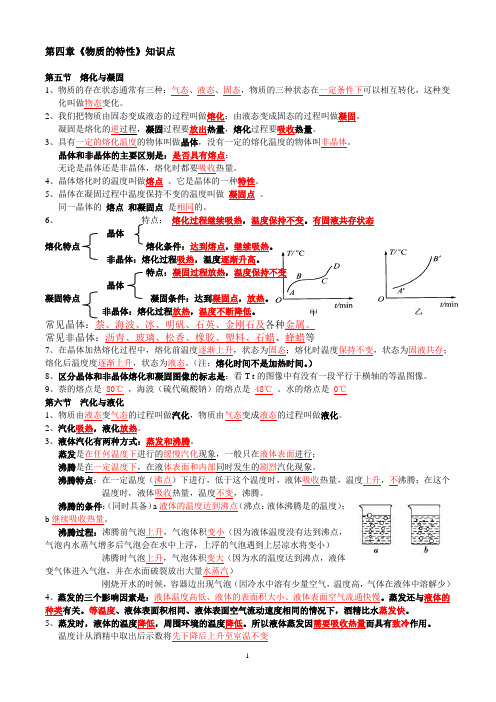
第四章《物质的特性》知识点第五节熔化与凝固1、物质的存在状态通常有三种:气态、液态、固态,物质的三种状态在一定条件下可以相互转化,这种变化叫做物态变化。
2、我们把物质由固态变成液态的过程叫做熔化;由液态变成固态的过程叫做凝固。
凝固是熔化的逆过程,凝固过程要放出热量,熔化过程要吸收热量。
3、具有一定的熔化温度的物体叫做晶体,没有一定的熔化温度的物体叫非晶体。
晶体和非晶体的主要区别是:是否具有熔点;无论是晶体还是非晶体,熔化时都要吸收热量。
4、晶体熔化时的温度叫做熔点。
它是晶体的一种特性。
5、晶体在凝固过程中温度保持不变的温度叫做凝固点。
同一晶体的熔点和凝固点是相同的。
6、特点:熔化过程继续吸热,温度保持不变。
有固液共存状态晶体熔化特点熔化条件:达到熔点,继续吸热。
非晶体:熔化过程吸热,温度逐渐升高。
特点:凝固过程放热,温度保持不变晶体凝固特点凝固条件:达到凝固点,放热。
非晶体:熔化过程放热,温度不断降低。
常见晶体:萘、海波、冰、明矾、石英、金刚石及各种金属。
常见非晶体:沥青、玻璃、松香、橡胶、塑料、石蜡、蜂蜡等7、在晶体加热熔化过程中,熔化前温度逐渐上升,状态为固态;熔化时温度保持不变,状态为固液共存;熔化后温度度逐渐上升,状态为液态。
(注:熔化时间不是加热时间。
)8、区分晶体和非晶体熔化和凝固图像的标志是:看T-t的图像中有没有一段平行于横轴的等温图像。
9、萘的熔点是80℃,海波(硫代硫酸钠)的熔点是48℃。
水的熔点是0℃第六节汽化与液化1、物质由液态变气态的过程叫做汽化,物质由气态变成液态的过程叫做液化。
2、汽化吸热,液化放热。
3、液体汽化有两种方式:蒸发和沸腾。
蒸发是在任何温度下进行的缓慢汽化现象,一般只在液体表面进行;沸腾是在一定温度下,在液体表面和内部同时发生的剧烈汽化现象。
沸腾特点:在一定温度(沸点)下进行,低于这个温度时,液体吸收热量,温度上升,不沸腾;在这个温度时,液体吸收热量,温度不变,沸腾。
浙教版七年级科学上册第四章《物质的特性》知识归纳
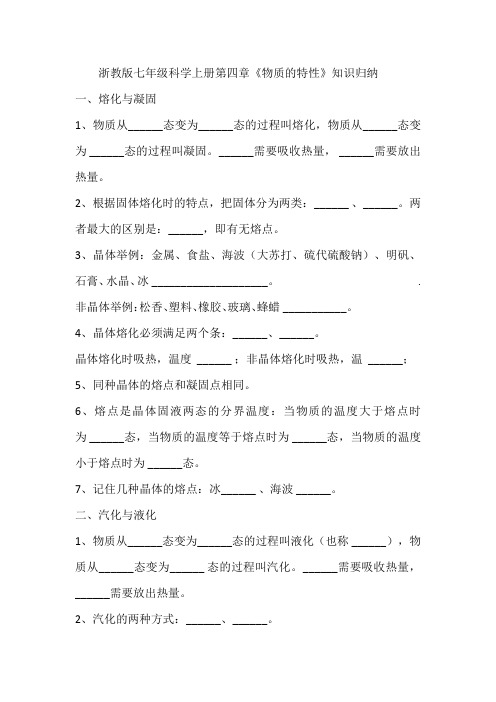
浙教版七年级科学上册第四章《物质的特性》知识归纳一、熔化与凝固1、物质从______态变为______态的过程叫熔化,物质从______态变为 ______态的过程叫凝固。
______需要吸收热量, ______需要放出热量。
2、根据固体熔化时的特点,把固体分为两类:______ 、______。
两者最大的区别是:______,即有无熔点。
3、晶体举例:金属、食盐、海波(大苏打、硫代硫酸钠)、明矾、石膏、水晶、冰 ____________________。
. 非晶体举例:松香、塑料、橡胶、玻璃、蜂蜡 ___________。
4、晶体熔化必须满足两个条:______、______。
晶体熔化时吸热,温度 ______ ;非晶体熔化时吸热,温 ______;5、同种晶体的熔点和凝固点相同。
6、熔点是晶体固液两态的分界温度:当物质的温度大于熔点时为 ______态,当物质的温度等于熔点时为 ______态,当物质的温度小于熔点时为 ______态。
7、记住几种晶体的熔点:冰______ 、海波 ______。
二、汽化与液化1、物质从______态变为______态的过程叫液化(也称 ______),物质从______态变为______ 态的过程叫汽化。
______需要吸收热量,______需要放出热量。
2、汽化的两种方式:______、______。
3、两种汽化方式的比较:4、影响蒸发快慢的三个因素:______、______、______5、液体沸腾的必须满足的两个条件:______、______。
液体沸腾时吸收热量,温度______。
6、沸点是液体 ______ 时的温度,不同的液体沸点 ______,因为液体的沸点还与液体表面气压有关,气压越大沸点越 ______,所以同一液体的沸点在不同情况下也是不同的。
7、记住标准大气压下水的沸点:______、酒精的沸点______ 。
8、液化的两种方法:______、______。
浙教版科学第四章《物质的特性》知识点归纳
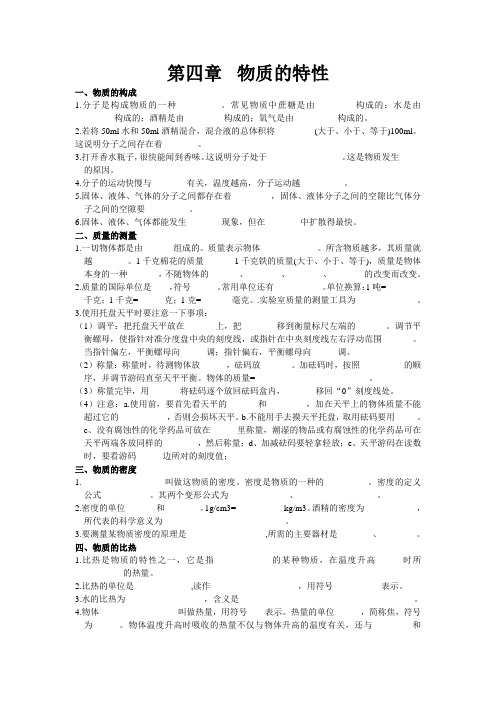
第四章物质的特性一、物质的构成1.分子是构成物质的一种__________。
常见物质中蔗糖是由_________构成的;水是由_________构成的;酒精是由_________构成的;氧气是由__________构成的。
2.若将50ml水和50ml酒精混合,混合液的总体积将_________(大于、小于、等于)100ml。
这说明分子之间存在着________。
3.打开香水瓶子,很快能闻到香味。
这说明分子处于_________________。
这是物质发生_____ 的原因。
4.分子的运动快慢与________有关,温度越高,分子运动越__________。
5.固体、液体、气体的分子之间都存在着_________,固体、液体分子之间的空隙比气体分子之间的空隙要__________。
6.固体、液体、气体都能发生________现象,但在________中扩散得最快。
二、质量的测量1.一切物体都是由_______组成的。
质量表示物体_____________。
所含物质越多,其质量就越________。
1千克棉花的质量_______1千克铁的质量(大于、小于、等于),质量是物体本身的一种_______,不随物体的_______、________、________、________的改变而改变。
2.质量的国际单位是____,符号______。
常用单位还有___________。
单位换算:1吨=________千克;1千克=______克;1克=_______毫克。
.实验室质量的测量工具为______________。
3.使用托盘天平时要注意一下事项:(1)调平:把托盘天平放在_______上,把________移到衡量标尺左端的_______。
调节平衡螺母,使指针对准分度盘中央的刻度线,或指针在中央刻度线左右浮动范围_______。
当指针偏左,平衡螺母向______调;指针偏右,平衡螺母向______调。
浙教版科学七上第四章
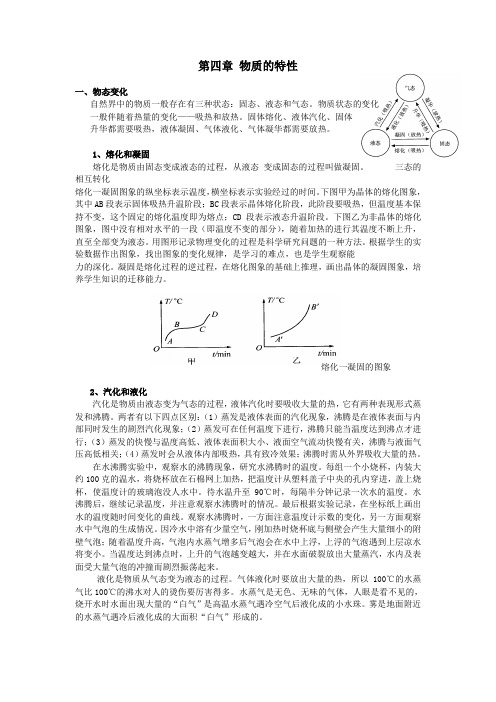
第四章物质的特性一、物态变化自然界中的物质一般存在有三种状态:固态、液态和气态。
物质状态的变化一般伴随着热量的变化——吸热和放热。
固体熔化、液体汽化、固体升华都需要吸热,液体凝固、气体液化、气体凝华都需要放热。
1、熔化和凝固熔化是物质由固态变成液态的过程,从液态变成固态的过程叫做凝固。
三态的相互转化熔化一凝固图象的纵坐标表示温度,横坐标表示实验经过的时间。
下图甲为晶体的熔化图象,其中AB段表示固体吸热升温阶段;BC段表示晶体熔化阶段,此阶段要吸热,但温度基本保持不变,这个固定的熔化温度即为熔点;CD段表示液态升温阶段。
下图乙为非晶体的熔化图象,图中没有相对水平的一段(即温度不变的部分),随着加热的进行其温度不断上升,直至全部变为液态。
用图形记录物理变化的过程是科学研究问题的一种方法。
根据学生的实验数据作出图象,找出图象的变化规律,是学习的难点,也是学生观察能力的深化。
凝固是熔化过程的逆过程,在熔化图象的基础上推理,画出晶体的凝固图象,培养学生知识的迁移能力。
熔化一凝固的图象2、汽化和液化汽化是物质由液态变为气态的过程,液体汽化时要吸收大量的热,它有两种表现形式蒸发和沸腾。
两者有以下四点区别:(1)蒸发是液体表面的汽化现象,沸腾是在液体表面与内部同时发生的剧烈汽化现象;(2)蒸发可在任何温度下进行,沸腾只能当温度达到沸点才进行;(3)蒸发的快慢与温度高低、液体表面积大小、液面空气流动快慢有关,沸腾与液面气压高低相关;(4)蒸发时会从液体内部吸热,具有致冷效果;沸腾时需从外界吸收大量的热。
在水沸腾实验中,观察水的沸腾现象,研究水沸腾时的温度。
每组一个小烧杯,内装大约100克的温水,将烧杯放在石棉网上加热,把温度计从塑料盖子中央的孔内穿进,盖上烧杯,使温度计的玻璃泡没人水中。
待水温升至90℃时,每隔半分钟记录一次水的温度。
水沸腾后,继续记录温度,并注意观察水沸腾时的情况。
最后根据实验记录,在坐标纸上画出水的温度随时间变化的曲线。
浙教版科学7年级知识点总结 第四章 物质的特性(1)
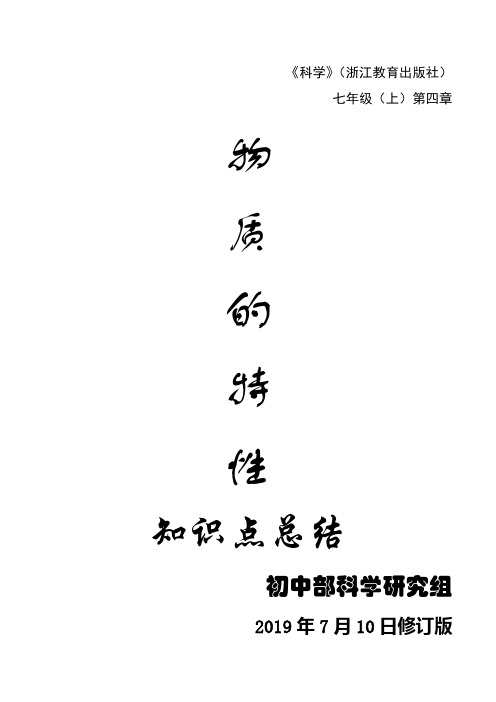
甲:直接取一枚大头针放在天平上测出它的总质量; 乙:取 100 枚大头针放在天平上测出它们总质量,再求出一枚大头针的质量。 丙:取 1000 枚大头针放在天平上测出它们总质量,再求出一枚大头针的质量。 你认为在实验操作无误的情况下,测量的结果最准确的是_________,测量的结果最不标准的是________, 在实际的实验方法中最合理的是___________? 例题 2 小明同学想知道一枚大头针的质量,决定用托盘天平进行测量。他使用的托盘天平如图所示(其游 码标尺放大置于天平下方)。他测量了四次,其测量结果记录如下表:
2、质量的单位 (1)质量的基本单位:千克,符号是 kg ______________是质量的基准 (2)质量的常用单位:_________、___________、______________。 常见单位之间的转换: 生活中 1 斤是_______g,1 斤鸡蛋大约是_______个,每个鸡蛋约为________g。一名中学生的质量大约是 _________kg。 二、质量的测量工具 1、常见的工具:案秤、磅秤、电子秤、杆秤 2、托盘天平的结构
- 1、下载文档前请自行甄别文档内容的完整性,平台不提供额外的编辑、内容补充、找答案等附加服务。
- 2、"仅部分预览"的文档,不可在线预览部分如存在完整性等问题,可反馈申请退款(可完整预览的文档不适用该条件!)。
- 3、如文档侵犯您的权益,请联系客服反馈,我们会尽快为您处理(人工客服工作时间:9:00-18:30)。
浙教版七年级上册科学第四章《物质的特性》知识点(新教材)第四章物质的特性第一节物质的构成物质的构成是由微粒组成的,其中分子是构成物质的一种微粒,其他微粒包括原子和离子。
分子是物质构成微粒中比较小的一种,分子之间存在空隙并不停地做无规则运动。
分子之间存在引力和斥力,同种物质分子的性质相同,而不同种物质分子的性质则不同。
气体分子之间空隙最大,液体分子次之,固体分子之间间隙比较小。
扩散现象说明了分子之间有空隙,并且分子在不停地做无规则运动。
分子运动的快慢与温度有关,温度越高,分子运动越剧烈,物质扩散也就越快。
如果将50毫升水和50毫升酒精混合,混合液的总体积将小于100毫升,这说明分子之间存在着一定的空隙。
蒸发和沸腾的微观解释都是基于分子的运动和离开液体表面的过程。
物质在发生状态变化时只是分子之间的空隙大小变化了,并没有产生别的物质,属于物理变化。
需要注意的是,分子运动与物体运动是不同的,扩散、蒸发等是分子运动的结果,而飞扬的灰尘、液体和气体的对流则是物体运动的结果,不属于分子的热运动。
水蒸气容易被压缩,而水和冰并不容易压缩。
这是因为水分子之间间隙差别较大,水蒸气的水分子之间的间隙较大,而水和冰的水分子之间间隙很小,所以水蒸气易被压缩,而水和冰不易被压缩。
第二节质量的测量质量是物质的一种属性,它不随温度、位置、形状、状态的变化而改变。
一切物体都是由物质组成,物体所含物质的多少叫做质量。
质量的主单位是千克,其他单位有吨、克和毫克。
常见的物体的质量范围是50克到6吨之间。
测量质量常用的工具有电子秤、杆秤和磅秤等。
实验室中常用托盘天平测量质量,托盘天平的基本构造是:When using a platform scale。
there are several things to keep in mind。
First。
make sure to place the scale on a level surface。
Second。
adjust the balance by moving the balance nut until the XXX of center。
If the pointer is leaning to the left。
adjust the balance nut on the left or move the balance nut on the right to the right。
Third。
make sure the weight of the object being measured does not exceed the capacity of the scale。
When adding weights。
estimate the weight and add them from XXX until the scale is balanced。
Do not use the balance nut to adjust the balance during weighing。
To read the weight。
use the formula: weight on left pan = total weight on right pan + weight XXX。
Do not place wet or chemical objects directly on the left pan。
Instead。
use two pieces of paper or two glass containers of equal weight on both pans。
If the object is accidentally placed on the right pan。
use the formula weight on right pan = total weight on left pan - weight XXX.Density is defined as the mass of a substance per unit volume。
It is a XXX constant for the same material。
regardless of its shape。
volume。
or mass。
The formula for density is ρ = m/v or m = ρv。
For the same substance。
ρ is constant and m is XXX different substances。
when v is constant。
the substance with a larger mwill have a larger ρ。
When m is constant。
the substance with a larger v will have a smaller ρ。
The density of mercury is 13.6 x10^3 kg/m^3.which means that the mass of 1 cubic meter of mercury is 13.6 x 10^3 kg。
The unit of density is typically kg/m^3 or g/cm^3.The nship een the two units is 1 g/cm^3 = 1000 kg/m^3or 1 kg/m^3 = 1 x 10^-3 g/cm^3.本文介绍了密度和比热的相关知识。
首先,水的密度是1×10千克/立方米或1克/立方厘米,单位转化中1毫升= 1立方厘米= 1×10立方米,1吨=1000千克=1×10克,1毫升= 1×10升,1升=10立方米。
其次,测量密度的原理是ρ=m/v,固体的测量步骤为先用天平称量物体的质量m,再用量筒或量杯测量物体的体积v,液体的测量步骤为先量取一定体积液体并称重M1,倒掉V体积液体,再称量剩余液体质量M2,最后计算液体密度ρ=(M1-M2)/V。
密度的应用包括在密度公式中,知道其中任意两个量,即可求得第三个量,可用于鉴别物质的种类,以及判断物体是否空心。
最后,比热是指1单位质量的某种物质,在升高(降低)1℃时所吸收(放出)的热量,叫做这种物质的比热容,简称为比热。
比热容是物质的特性,可以用来鉴别物质。
比热单位为焦/(千克×℃),读作焦每千克摄氏度,符号为J/(kg.℃)。
33水的比热是4.2×10焦/(千克×℃),这意味着当1kg的水温度升高1℃时,需要吸收4.2×10焦的热量。
比热容实质上反映了物质吸热和放热的能力,比热容越大,物质的吸热或放热能力越强。
同时,比热容也反映了物质对冷热反应的灵敏程度,比热容越小,物质对冷热反应的灵敏程度越高。
比热表的阅读需要注意几点。
首先,水的比热最大,这表明水在冷却和保温方面具有重要作用。
其次,不同物质的比热是不同的,因此比热是物质的一种特性,与物质的质量、升高的温度、吸放热量无关。
最后,同一种物质在不同状态下的比热也不同,这说明比热与物质状态有关。
沿海地区的气温变化相对较小,而内陆地区的气温变化较大。
在同一纬度下,海洋和陆地的气温变化也不同。
冬季,陆地的降温速度比海洋快,夏季则相反。
这是因为海洋(水)的比热容比陆地(岩石)要大,因此升温的速度较慢。
物质存在的状态通常有三种:气态、液态、固态。
物质的状态可以在一定条件下相互转化,这种变化称为物态变化。
熔化是将物质由固态变成液态的过程,而凝固则是液态变成固态的过程。
凝固是熔化的逆过程,凝固过程会放出热量,而熔化过程则需要吸收热量。
晶体具有一定的熔点,而非晶体则没有一定的熔点。
晶体和非晶体的主要区别在于是否具有熔点。
无论是晶体还是非晶体,在熔化时都需要吸收热量。
晶体熔化时的温度称为熔点,是晶体的一种特性。
晶体在凝固过程中温度保持不变的温度称为凝固点,同一晶体的熔点和凝固点是相同的。
晶体熔化过程吸热,温度保持不变,而凝固过程放热,温度也保持不变。
常见的晶体有萘、海波、冰、石英、金刚石以及各种金属,而常见的非晶体有沥青、玻璃、松香、橡胶、塑料、石蜡等。
物质由液态变成气态的过程称为汽化,而由气态变成液态的过程称为液化。
汽化过程需要吸热,而液化过程则放热。
液体汽化有两种方式:蒸发和沸腾。
蒸发是指液体在任何温度下进行的汽化现象,一般只在液体表面进行。
而沸腾是在一定温度下,在液体表面和内部同时发生的剧烈汽化现象。
沸腾的特点是在一定温度(沸点)下进行,低于这个温度时,液体吸收热量,温度上升,不沸腾;在这个温度时,液体吸收热量,温度不变,沸腾。
沸腾的条件是同时具备:a液体的温度达到沸点(沸点即液体沸腾时的温度);b继续吸收热量。
沸腾过程中,沸腾前气泡上升,气泡体积变小(因为液体温度没有达到沸点,气泡内水蒸气增多后气泡会在水中上浮,上浮的气泡遇到上层凉水将变小)。
而沸腾时,气泡上升,气泡体积变大(因为水的温度达到沸点,液体变气体进入气泡,并在水面破裂放出大量蒸汽)。
刚烧开水的时候,边出现气泡,这是因为冷水中溶有少量空气,温度高,气体在液体中溶解少。
蒸发的三个影响因素是:液体温度高低、液体的表面积大小、液体表面空气流通快慢。
蒸发时,液体的温度降低,周围环境的温度也随之降低。
温度计从酒精中取出后示数将先下降后上升。
下降是因为玻璃泡上的酒精在蒸发时要吸收热量,后上升是因为酒精蒸发完后回到室温。
液化是物质从气态变为液态的过程,也叫凝结。
同一物质,液化温度和沸点相同。
气体液化时要放出大量的热,因此100℃的水蒸气比100℃的沸水对人的烫伤要厉害得多。
液化的方法有:降低温度、压缩体积。
气压低,沸点低(例如高压锅、一个标准大气压、高山上)。
电冰箱就是利用低沸点的冷凝剂在汽化时,从冷冻室吸热,又利用压缩机将气体的冷凝剂液化,向外放热,而将从冰箱的冷冻室“搬”到冰箱外面的。
热管温控技术,管内工作的液体在高端汽化吸热,在低端液化放热。
水蒸气是无色、无味的气体,人眼是看不见的,烧开水时水面出现大量的“白气”是高温水蒸气遇冷空气后液化成的小水珠(冰棒雪糕的白气也是同理)。
雾是地面附近的水蒸气遇冷后液化成的大面积“白气”形成的。
升华是指物质直接从固态变成气态的过程,需要吸热。
和酸碱性是物质的化学性质之一。
2、溶解性是指物质在溶剂中的溶解度,通常用溶解度来描述。
例如,盐的溶解度是指在一定温度下,溶液中能够溶解的盐的最大质量。
3、酸碱性是指物质在水溶液中的酸碱性质,通常用pH值来描述。
pH值越小,表示酸性越强;pH值越大,表示碱性越强;pH值为7表示中性。
